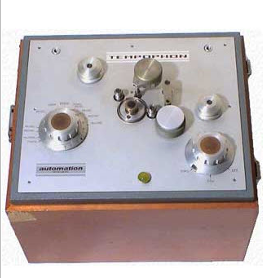A Short History of Granular Synthesis – Part 2
A Short History of Granular Synthesis – Part 2
If you want to support my work, please make use of the "PayPal" button - thank you very much indeed!

A Company in the small town of Heidelberg (West Germany) developed an electro-mechanical device called the Tempophon, which not only allowed to manipulate the speed of a sound and its pitch independenly from each other – the most basic operation of granular processing of sound – but was also able to repeat a small part of the sound, let me call it a grain, as often as the user wants it to be repeated.
The German composer Herbert Eimert made use of this device, when he created his exclusively speech (human voice) based piece “Epitaph for Aikichi Kuboyama” in 1963. Whereas the Tempophon showed the direction in which the technical development of granular sound processing should (and would) go, it was Eimert who demonstrated the potential of this technique in terms of musical meaning.
In “Epitaph für Aikichi Kuboyama” as the German original is called, the words, which are engraved in the tombstone of the first civil victim of after-war tests of hydrogen bombs, are recited and gradually manipulated and alienated using the principles of granular sound processing (with the Tempophon). The sonic result evokes pictures of the unvisibly approaching death in form of nuclear radiation, of dissolving plasmosomes in the human body while the spoken words more and more dissolve into unintelligible particles of sound.
Xenakis´ approach to sonic grains was a more analytical one. Eimert´s main objective lay in purposefully targeted alienation of sonic material, a route, which has prevailed the use of granular sound processors up to now – even if purposefulness and compositional will and meaning have to give way to empty and geeky razzle-dazzle quite often nowadays.
It was clear, that (electro-)mechanical based devices would reach their limits quite soon when it comes to dealing with shorter and ever shorter grains of sound on one hand, and to manipulating the content of these grains on the other hand.

But before it could come to the first implementations of working with sound on the level of grains in computer systems, it took the works of scientists like Norbert Wiener, Abraham Moles, (and later in the early 1980s also the Dutch Martin J. Bastiaans) and others, people, who were willing and able to think beyond the commonly set borders of their special fields of science. Even if their approach to the matter was a clean analytical and descriptive one, they (mathematically) prepared the field for later developments of computer software, that was able to work with sonic grains faster, more detailed, and enabled the manipulation of the content of the sonic grains in manifold ways.

There was a kind of a lull in the development of granular techniques as well as in their musical application during the 1970s. The big spotlights were more on generating sound and on manipulating and modulating sound on the macroscopic level: voltage controlled oscillators, voltage controlled filters, voltage controlled amplifiers – in other words: synthesizers were the main matter of interest in electronic music. “Only” analog at first, then digital with pioneers like Chowning and the company Yamaha on the field of frequency modulation and phase modulation, building a bridge to computer technology.
But the granular approach to sound hadn´t completely gone to sleep during the 1970s. Mainly the development of software went on (see chapter “Software” later in this book). And so it was the marriage of musical spirit of enterprise and computer technology, that made granular sound processing reappear in the early 1980s, namely in the works of the French composer Jean Claude Risset and the American scientist and and composer David L. Wessel.
You find more comprehensive material about granular sound processing here: https://www.dev.rofilm-media.net/node/332
... to be continued
to part 1: https://www.dev.rofilm-media.net/node/340
to part 3: https://www.dev.rofilm-media.net/node/346
to part 4: https://www.dev.rofilm-media.net/node/357
to "In the World of Grains" part 1: https://www.dev.rofilm-media.net/node/364
to "In the World of Grains" part 2: https://www.dev.rofilm-media.net/node/373
to "Inthe World of Grains" part 3: https://www.dev.rofilm-media.net/node/378
to "In the World of Grains" part 4: https://www.dev.rofilm-media.net/node/385
to "In the World of Grains" part 5: https://www.dev.rofilm-media.net/node/390
to "In the World of Grains" part 6: https://www.dev.rofilm-media.net/node/398
to "In the World of Grains" part 7: https://www.dev.rofilm-media.net/node/407
to "In the World of Grains" part 8: https://www.dev.rofilm-media.net/node/414
to "in the World of Grains" part 9: https://www.dev.rofilm-media.net/node/421

Add new comment